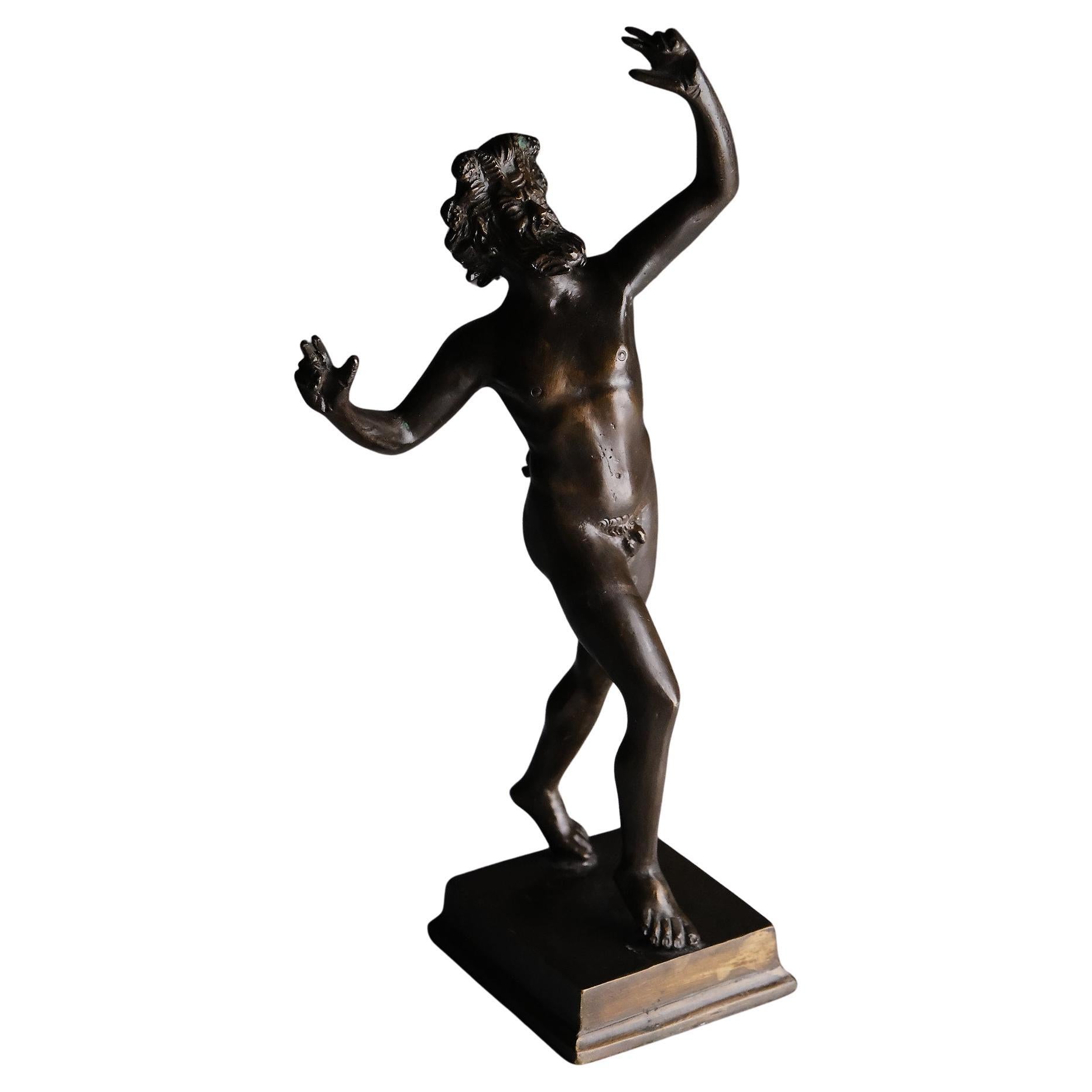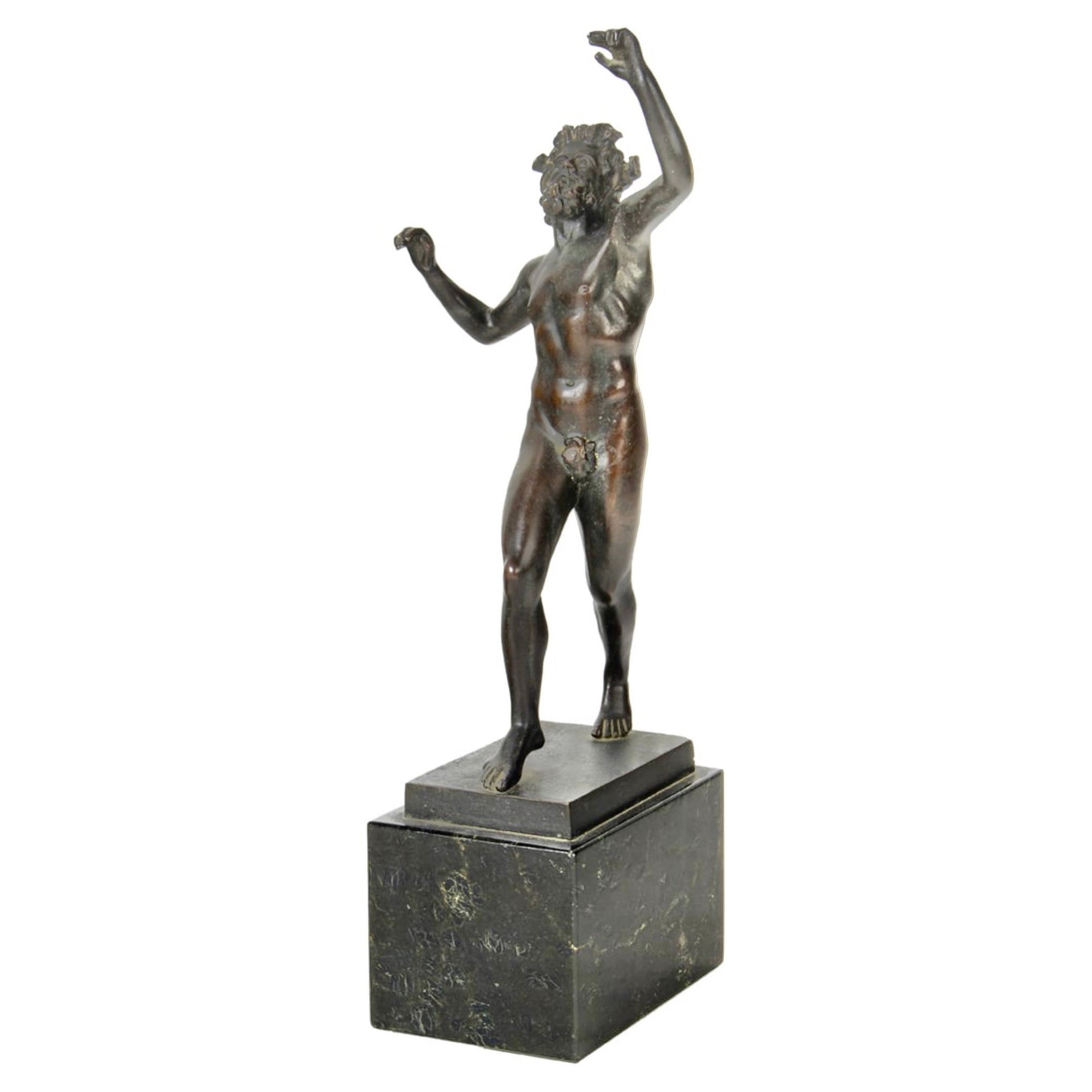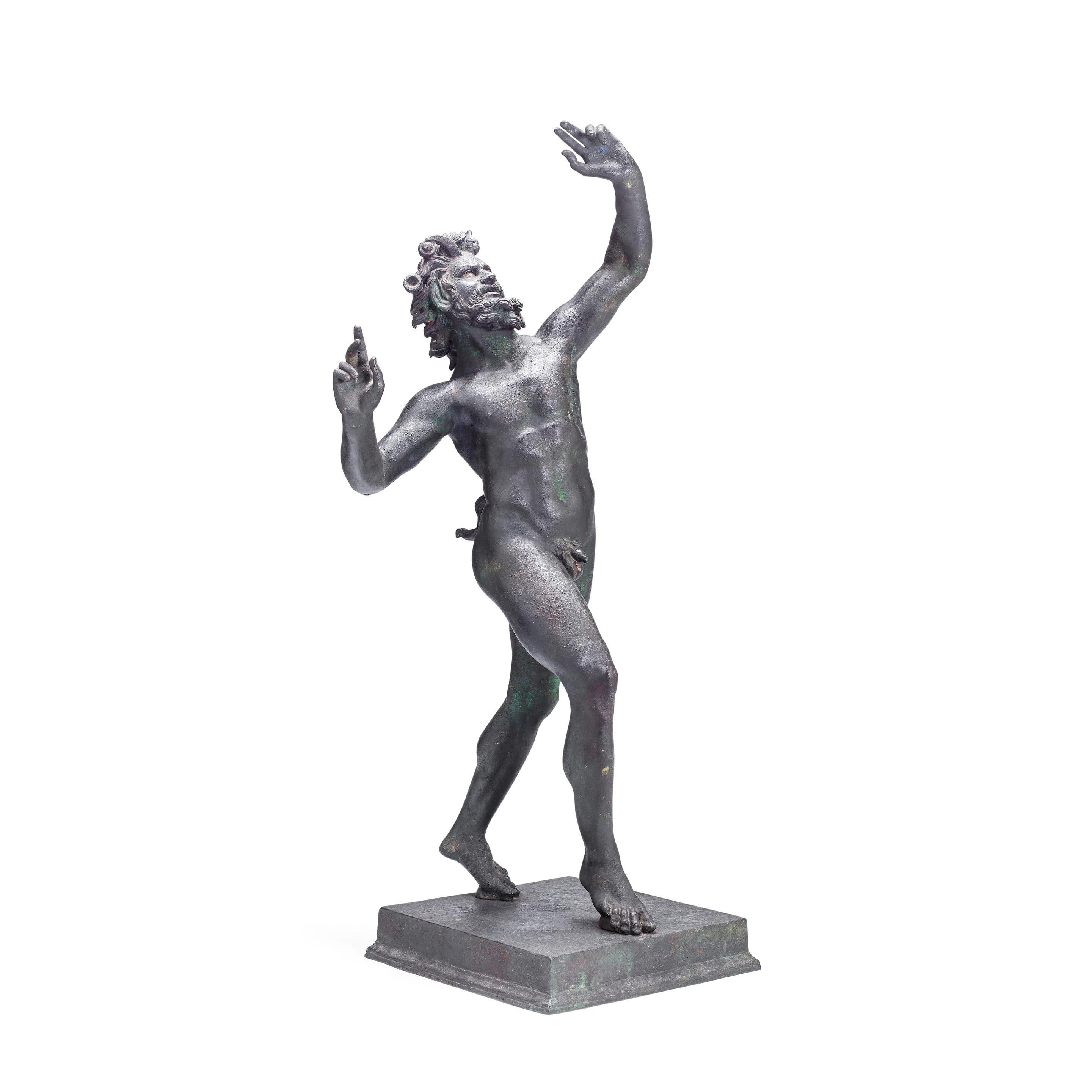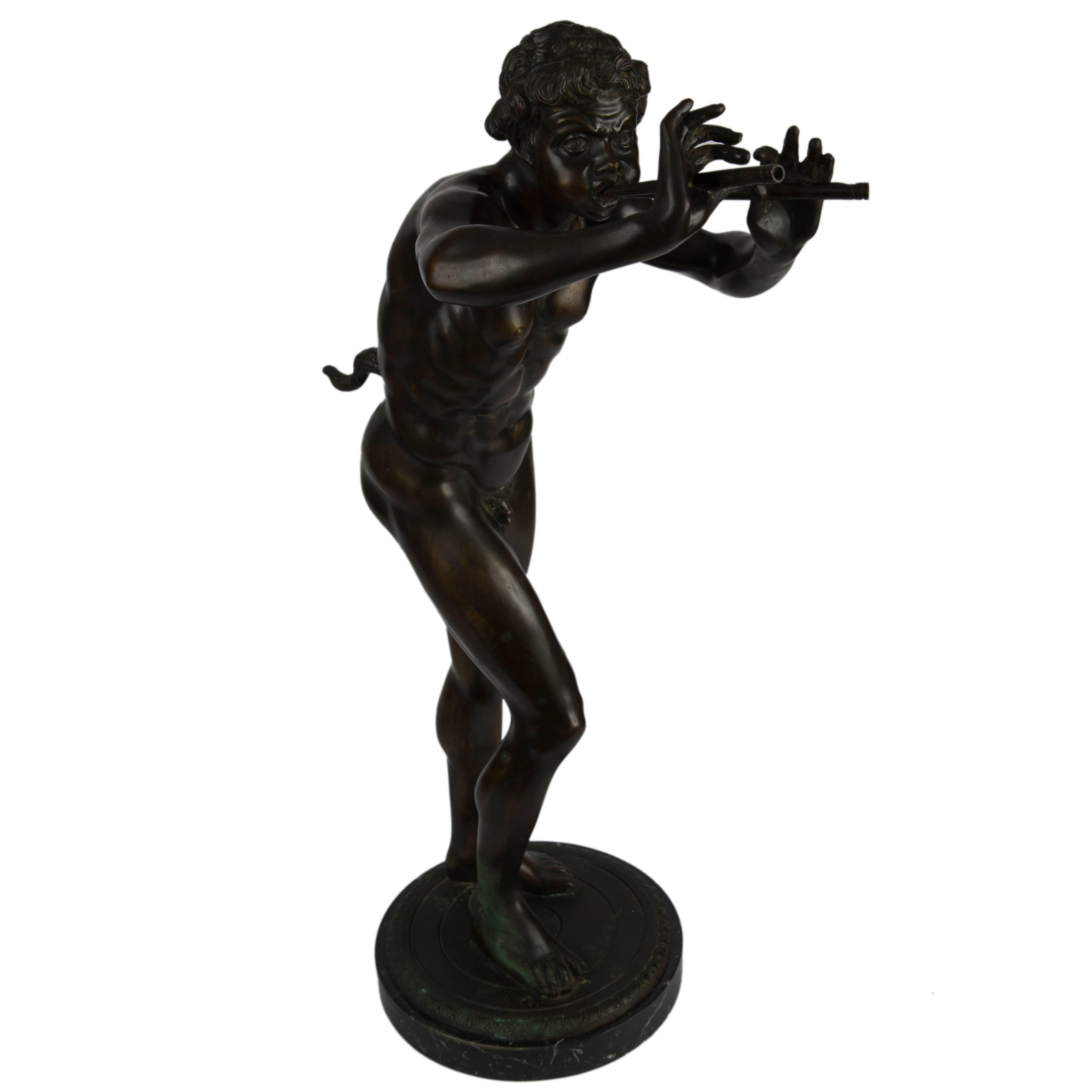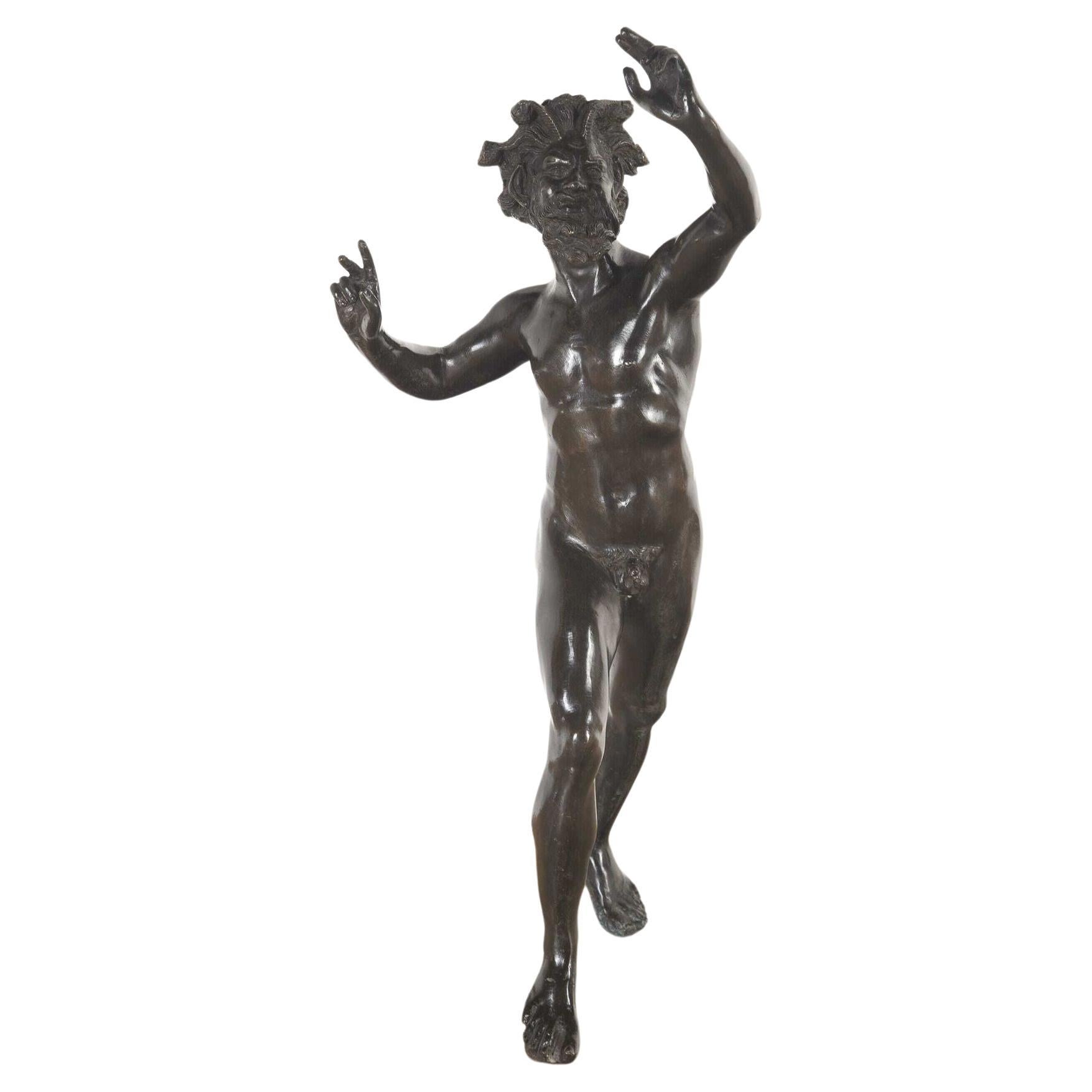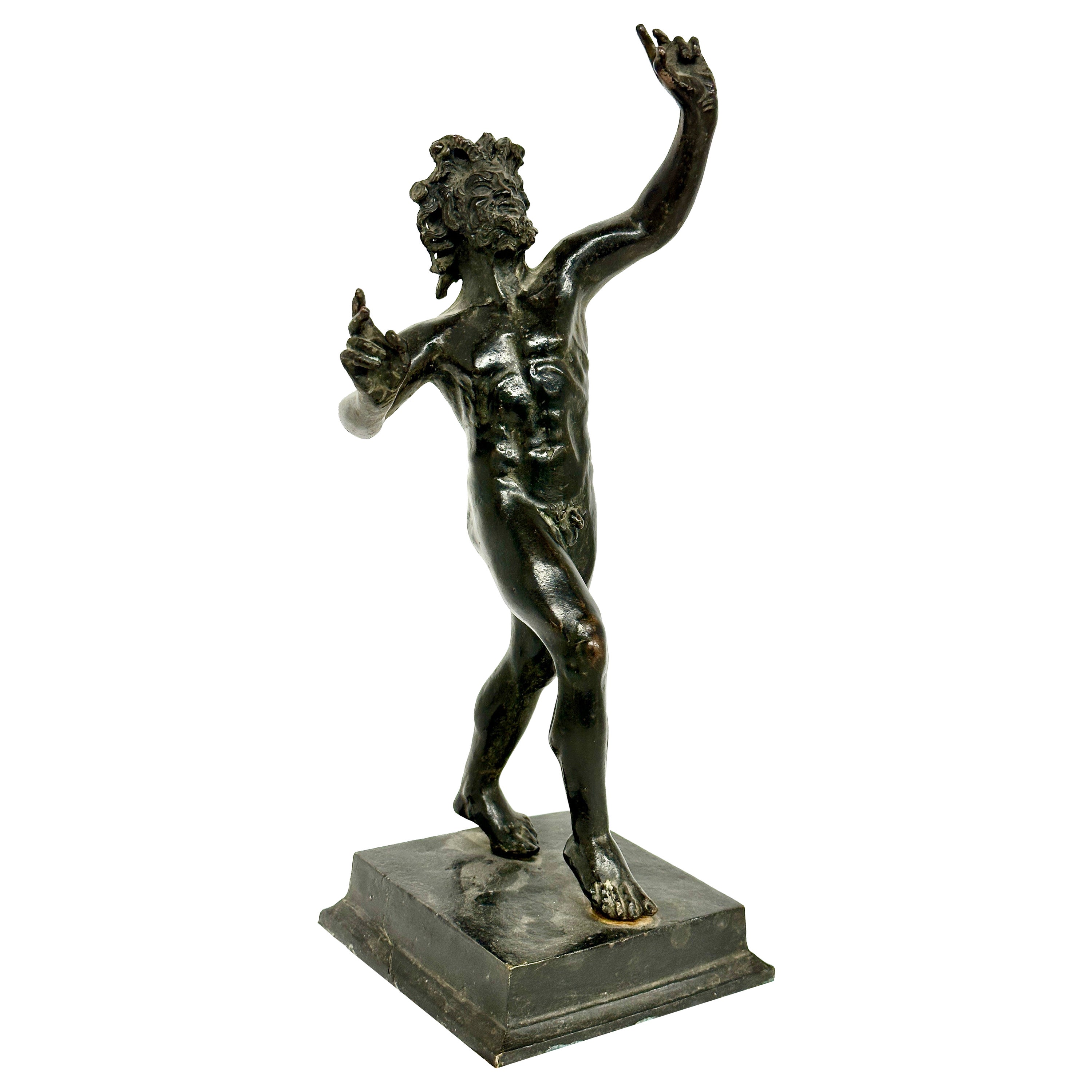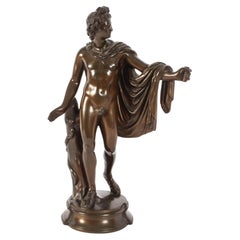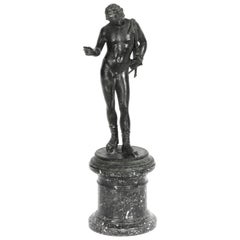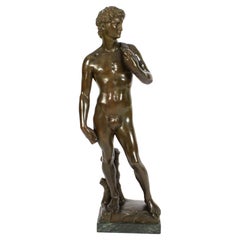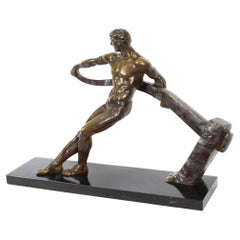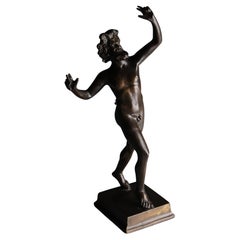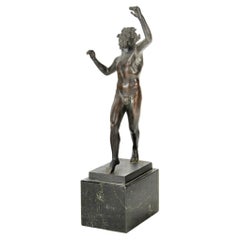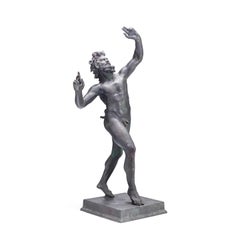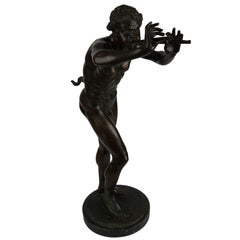Items Similar to Antique Large Bronze of Pan Dancing Musee de Naple, 1870s
Want more images or videos?
Request additional images or videos from the seller
1 of 20
Antique Large Bronze of Pan Dancing Musee de Naple, 1870s
$3,017
£2,200
€2,572.88
CA$4,213.62
A$4,572.82
CHF 2,406.02
MX$55,559.89
NOK 30,122.94
SEK 28,363.49
DKK 19,210.51
About the Item
This is a large French Grand Tour bronze sculpture of Pan the Roman fertility God of the forest issued by the "Musee de Naple" , circa 1870 in date.
The sculpture features Pan dancing naked, he has horns, flowing hair and a tail. The statue rests on a rectangular bronze base with is signed "Musee de Naple".
The attention to detail is absolutely fantastic and the sculpture is extremely life-like.
Condition:
In really excellent condition, please see photos for confirmation.
Dimensions in cm:
Height 53 x Width 22 x Depth 15
Dimensions in inches:
Height 1 foot, 9 inches x Width 9 inches x Depth 6 inches
Pan
The culture of Ancient Greece involved a complex spiritual world of major and minor gods that oversaw human events and engaged in dramas of their own. One of these, called Pan, ruled over nature and pasturelands. He is frequently depicted in literature and artworks. Although he is not one of the major gods of Ancient Greece, he is one of most often referenced figures in Greek mythology.
Pan the God of the Wild
Pan is considered to be one of the oldest of GREEK GODS. He is associated with nature, wooded areas and pasturelands, from which his name is derived. The worship of Pan began in rustic areas far from the populated city centers. Therefore, he did not have large temples built to worship him. Rather, worship of Pan centered in nature, often in caves or grottos. He ruled over shepherds, hunters and rustic music. He was the patron god of Arcadia. Pan was often in the company of the wood nymphs and other deities of the forest.
Pan’s Appearance
Perhaps because of his association with nature and animals, Pan did not have the appearance of a normal man. The bottom half of his body was like a goat, with the top half of his body being like other men. However, he is often depicted with horns on his head, and his face is usually unattractive.
Pan’s Lineage
The parentage of Pan is uncertain. Some accounts say he is the son of HERMES and Dryope. Others say he is the son of ZEUS or the son of Penelope, wife of Odysseus. The story of his birth says that his mother was so distressed by his unusual appearance that she ran away, but he was taken to Mount Olympus where he became the favourite of the gods.
Pan’s Powers
Like the other GODS OF OLYMPUS, Pan possessed enormous strength. He could also run for long periods of time and was impervious to injury. It was believed he could transform objects into different forms and was able to teleport himself from Earth to Mount Olympus and back. He is depicted as very shrewd with a wonderful sense of humour.
In Ancient Roman mythology, a SIMILAR GOD is called Faunus.
Pan and Music
The MYTHOLOGICAL STORIES involving Pan usually involve his romantic interest in a lovely goddess of the woods who spurns his advances and gets turned into an inanimate object to escape him or who otherwise flees from his ugly appearance. One story concerns Syrinx, a beautiful wood nymph. She flees from Pan’s attentions, and her follow goddesses turn her into a river reed in order to hide her from him. As the winds blow through the reeds, they make a gentle musical sound. Because he does not know which reed Syrinx is, he cuts several from reeds from the group and set them in a line to make the musical instrument, the pan flute. Pan’s image is often depicted with this instrument.
Pan Gave Humans the Word “Panic”
One story involving Pan is the tale of war, in which Pan helps his friend survive a vicious struggle by letting out an immense cry that frightened the enemy and caused him to run away. From this story, we get the word “panic,” the sudden, uncontrollable fear that leads people into irrational behavior.
Pan in the Modern World
Over the ages, Pan has been a symbol of the force of nature. In the 1800s, interest in this mythological figure revived, and communities organized festivals in which Pan was the central figure. Mythical stories of his antics abound, and he continues to be a figure representing the ancient mystery of the forest, hunting activities and wildlife.
Like the OTHER GODS of Ancient Greece, Pan embodies many of the qualities of the world over which he ruled. He is depicted as energetic, sometimes frightening, with the wild, unbridled creative force of nature that makes him an interesting, and often entertaining, character.
Our reference: A3528
- Dimensions:Height: 20.87 in (53 cm)Width: 8.67 in (22 cm)Depth: 5.91 in (15 cm)
- Style:Grand Tour (In the Style Of)
- Materials and Techniques:
- Place of Origin:
- Period:
- Date of Manufacture:Circa 1870
- Condition:
- Seller Location:London, GB
- Reference Number:Seller: A35281stDibs: LU950636419792
About the Seller
5.0
Platinum Seller
Premium sellers with a 4.7+ rating and 24-hour response times
Established in 1983
1stDibs seller since 2012
1,402 sales on 1stDibs
Typical response time: <1 hour
Associations
LAPADA - The Association of Arts & Antiques Dealers
- ShippingRetrieving quote...Shipping from: London, United Kingdom
- Return Policy
Authenticity Guarantee
In the unlikely event there’s an issue with an item’s authenticity, contact us within 1 year for a full refund. DetailsMoney-Back Guarantee
If your item is not as described, is damaged in transit, or does not arrive, contact us within 7 days for a full refund. Details24-Hour Cancellation
You have a 24-hour grace period in which to reconsider your purchase, with no questions asked.Vetted Professional Sellers
Our world-class sellers must adhere to strict standards for service and quality, maintaining the integrity of our listings.Price-Match Guarantee
If you find that a seller listed the same item for a lower price elsewhere, we’ll match it.Trusted Global Delivery
Our best-in-class carrier network provides specialized shipping options worldwide, including custom delivery.More From This Seller
View AllAntique Victorian Bronze Sculpture of Greek God Apollo 19th Century
Located in London, GB
This is a truly magnificent antique Victorian patinated bronze sculpture of the famous Greek God Apollo, modelled upon a shaped circular socle, inscribed monogram 'NF' and numbered 2...
Category
Antique 1860s English Victorian Figurative Sculptures
Materials
Bronze
Antique Grand Tour Patinated Bronze Figure of Narcissus 1870, 19th Century
Located in London, GB
This is a superb antique Grand Tour patinated bronze figure of Narcissus, dating from the last quarter of the 19th Century.
Narcissus was a hunter in Greek mythology and he was di...
Category
Antique 1870s Figurative Sculptures
Materials
Bronze
Antique Monumental Grand Tour Bronze of Michelangelo David 19th Century
Located in London, GB
This is an elegant monumental Grand Tour bronze sculpture of Michelangelo's David, circa 1880 in date.
The full-length portrait statue is of David, the 14ft marble statue depicts the Biblical hero David, represented as a standing male nude, David looks tense and ready for battle after he has made the decision to fight Goliath, but, before the battle has actually taken place. His brow is drawn, his neck tense, and the veins bulge out of his lowered right hand and holding his slingshot over his shoulder.
This impressive scuplture is 107cm (3ft 6" ) tall and weighs over 36kgs (79lbs).
This high quality hot cast solid bronze was produced using the traditional 'lost wax' process.
The attention to detail of this sculpture is absolutely fantastic.
Condition:
In really excellent condition, please see photos for confirmation.
Dimensions in cm:
Height 107 x Width 41 x Depth 24.5
Weight 36.3 kg
Dimensions in inches:
Height 3 foot, 6 inches x Width 1 foot, 4 inches x Depth 10 inches
Weight 80.0 lbs
Michelangelo's David
This astonishing Renaissance sculpture was created between 1501 and 1504. It is a 14ft marble statue depicting the Biblical hero David, represented as a standing male nude. Originally commissioned by the Opera del Duomo for the Cathedral of Florence, it was meant to be one of a series of large statues to be positioned in the niches of the cathedral’s tribunes, way up at about 80mt from the ground. Michelangelo was asked by the consuls of the Board to complete an unfinished project begun in 1464 by Agostino di Duccio and later carried on by Antonio Rossellino in 1475. Both sculptors had in the end rejected an enormous block of marble due to the presence of too many “taroli”, or imperfections, which may have threatened the stability of such a huge statue...
Category
Antique 1880s Figurative Sculptures
Materials
Bronze
Antique Art Deco Bronze Figure by Maurice Guiraud-Rivière 20th Century
By Maurice Guiraud-Rivière
Located in London, GB
A large fine Art Deco patinated bronze figure of "The Riverman" by Maurice Guiraud-Rivière (French, 1881-1947), circa 1920 in date.
This powerful sculpture is modelled and cast a...
Category
20th Century French Art Deco Figurative Sculptures
Materials
Bronze
Antique Grand Tour Patinated Bronze Figure of of David 19th Century
Located in London, GB
This is a superb large antique Grand Tour patinated bronze version of David, dating from the mid 19th Century.
The bronze statue depicts David with an enigmatic smile posed with ...
Category
Antique 1850s Figurative Sculptures
Materials
Bronze
Vintage Art Deco Bronze Dancing Girl After Chiparus Mid 20th C
Located in London, GB
This is an eye-catching Vintage Art Deco Revival bronze dancing girl dating from the mid 20th century.
This beautiful piece is a 20th Century recast of a sculpture created by the famous Romanian sculptor Demetre Chiparus.
Made by the classical lost wax, or 'cire perdue', method, the stautue stands on a black marble base.
Condition:
In excellent condition, please see photos for confirmation.
Dimensions in cm:
Height 50 x Width 22 x Depth 16 & Weight 6 kg
Dimensions in inches:
Height 1 foot, 8 inches x Width 9 inches x Depth 6 inches & Weight 13.2 lbs
Lost Wax Method
sometimes called by the French name of cire perdue or the Latin, cera perduta is the process by which a bronze or brass is cast from an artists sculpture.
In industrial uses, the modern process is called investment casting. An ancient practice, the process today varies from foundry to foundry, but the steps which are usually used in casting small bronze sculptures in a modern bronze foundry are generally quite standardised.
Demetre H. Chiparus
was born in Romania in 1886, attended school in Italy, then, shortly before World War I moved to Paris. He attended school at the Ecole des Beaux Arts under two talented sculptors Anonin Mercier and Jean Boucher, who provided him the opportunity to learn the trade.
He later began to experiment with small bronze sculptures and produce small bronze works, exhibiting his small sculptures and, in 1914, was awarded an honorable mention at the Salon of the Societe des Artistes Francais. Many of Paris’ most affluent began to take notice of his work after World War One and the demand for his sculptures quickly increased.
Chiparus was captivated by dancers, in particular influenced by Diaghiley’s Ballets Russes and Leon Bakst’s stage designs. A few of his famous sculptures were Starfish Dancer...
Category
Vintage 1950s Art Deco Figurative Sculptures
Materials
Bronze
You May Also Like
Bronze sculpture "The dancing faun of Pompeii", Italy, 20th century
Located in Eskilstuna, SE
Great sculpture after the antique "The danicing faun of Pompeii".
Made in bronze with beautiful details.
Category
Early 20th Century Italian Grand Tour Figurative Sculptures
Materials
Bronze
German Foundry NeoClassical Grand Tour Bronze of the Neapolitan Dancing Faun
Located in Palm Springs, CA
A lovely and well cast example of the Pompeian Dancing Faun. This grand tour bronze stands approx 12 inches tall on it’s marble base and is about half size of the original unearthed...
Category
Early 20th Century German Figurative Sculptures
Materials
Bronze
Late 19th century Grand Tour bronze of the Dancing Faun
Located in Bath, Somerset
A 19th century 'Grand Tour' bronze figure of the Dancing Faun, standing on a bronze square plinth. The faun balances on his toes and pivots, his horned head raised, his hair wreathe...
Category
Late 19th Century Figurative Sculptures
Materials
Bronze
Large Bronze Grand Tour Statue of Pan
Located in New York, NY
Standing figure of nude pan playing pipes. After the antique.
Category
Antique 19th Century Italian Figurative Sculptures
Materials
Bronze
20th Century Bronze Sculpture of a Dancing Faun
Located in Gloucestershire, GB
Classic and well-modelled sculpture of a dancing faun.
Category
20th Century British Sculptures and Carvings
Materials
Bronze
Dancing Faun of Pompeii Bronze Grand Tour Souvenir
Located in Palm Springs, CA
A lovely and well cast example of the Pompeian Dancing Faun. This grand tour bronze stands approx 11.75 inches tall about half size of the original unearthed in Pompeii. Beautiful p...
Category
Early 20th Century Italian Figurative Sculptures
Materials
Bronze
